The Vanishing Fishermen of Teesta
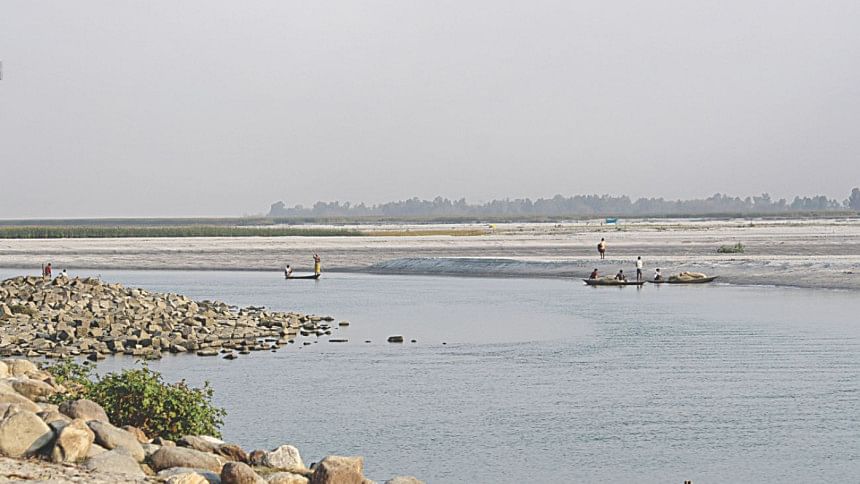
“In the last 15 years, I had to change homes 11 times. During every monsoon, Teesta swallows my residence and most of my belongings. My forefathers used to cultivate these lands and fish in this river and in the Shutungar beel (large lake-like wetland). I have heard from my grandma that fish was so plenty in this river that we used to sell only those of considerable size and weight. She used to feed our dogs and cats with small fries and catches of undesired species such as Gajars (Large Snakehead), Gechhua, Bain (Mud-Eel) etc. These are stories from bygone years. At present, Teesta means nothing to us except destruction,” says Mohammad Lal Mia, a resident of South Kharibari village under Dimlaupazila of Nilphamari district.
This village, situated along the course of the Teesta River, has been heavily affected by two major barrages built on both its sides; in the north Gajoldoba barrage established by the Indian government and in the south Teesta barrage, built by the Bangladesh government. In 1990, the Bangladesh government completed the construction of the Teesta barrage to provide irrigation to drought-prone districts of North-Bengal during dry seasons. However, in 1996, the Indian government established the Gajoldoba barrage, bigger than the Teesta barrage, on the upstream of the river for the same purpose. As the Indian barrage withdraws water during every dry season, Teesta River in Bangladesh turns into massive chars (tract of land formed by siltation and surrounded by river). Bangladesh's Teesta Barrage can do little to irrigate the lands due to intense water shortage.
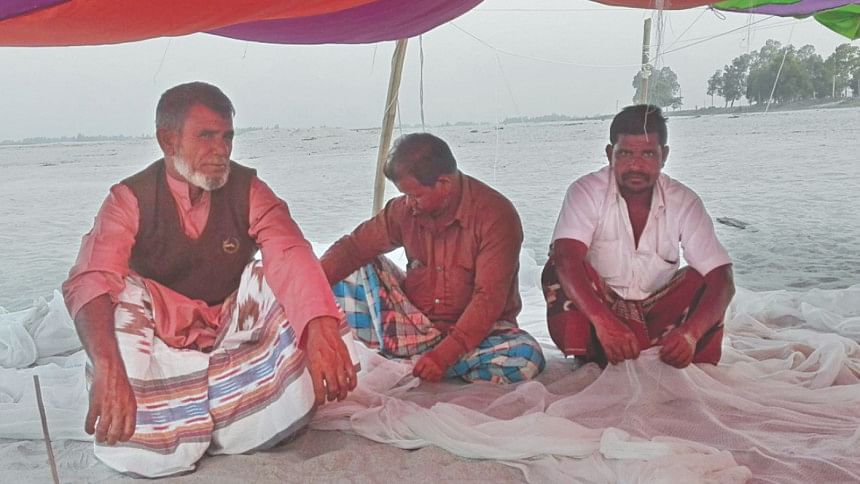
During monsoon, when water is released from the Indian barrage, rushing streams wash away everything in its path. Resisted by the massive chars and silted river-bed, Teesta overflows its banks, swallowing croplands and village after village.
According to Lal Mia and his neighbours, the river becomes so furious during the rainy season that regular crop cultivation and fishing become almost impossible in these parts. On the other hand, during dry season, the areas in between the barrages become so dry and sandy that nothing can be cultivated except some corns and wheat. “To produce crops, you need plenty of water. Wheat, corn can be cultivated in arid land but still plenty of water is needed to irrigate the crops. The sands of the chars become so dry and hot during daytime that we cannot plant anything on them. We can only plant on the relatively wet strips of chars which produce a very little amount of low-grade crops,” says Md Shukkur Ali, a neighbour of Lal Mia. Again, the narrow flowing stream of Teesta is so shallow and produces such a small number of fish that it cannot feed the fishing communities that live along its banks.
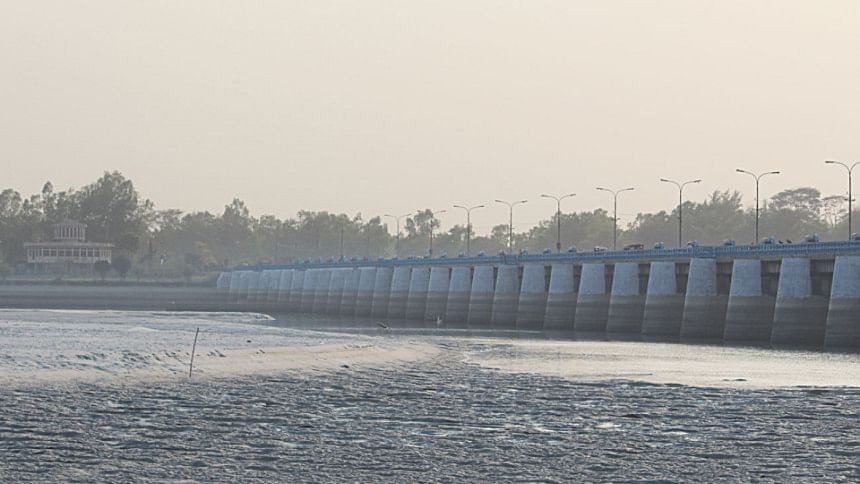
Around 300 fishermen families in South Kharibari and Tepa Kharibari villages depended on the bounty of Teesta River and Shutungar Beel for their livelihood, according to Lal Mia. As the large wetland fed by Teesta dried up completely, with the river now virtually unsuitable for cultivation and fishing, most of these fishermen have migrated to other cities and some of them,like Lal Mia, have been living on occasional farming and by selling menial labour in the urban areas during monsoon.
In Doani village located under Hatibandha upazila of Lalmonirhat district some 20 kilometres down the Teesta River and on the immediate downstream of Teesta barrage, we found a different scenario. A narrow stream of the once mighty Teesta was flowing through the mostly locked sluice gates of the barrage and forming shallow pond-like stagnant water bodies in the immediate downstream areas of the river. Hundreds of people with boats and fishing nets were busy catching fish in the murky waters. Some had even set up tents to stay overnight to catch fish: a picture quite opposite to the one described by Lal Mia and his neighbours, who claimed that most of the fishermen had already left the area. The many boats anchored along the chars surrounding the shallow water bodies from all sides proved that these fishermen had been coming in to fish in this area for many days.
In one of the tents we found a fisherman called Abu Bakar Siddique who was repairing his net for some night-time fishing. As we asked him questions about his work, he grew frightened as he thought that we were Teesta Barrage officials. He laughed in relief when we assured him that we were journalists and researchers looking for fishermen. “There is no river. How will you find fishermen here?” he asked. When we wanted to know about the fishing activities he and his fellow villagers had been doing, he said, “No, no sir. Originally we are not fishermen. Our reduced circumstances have forced us to take this job. In these parts, fishermen are lower caste Hindus. They have left these areas long ago.”
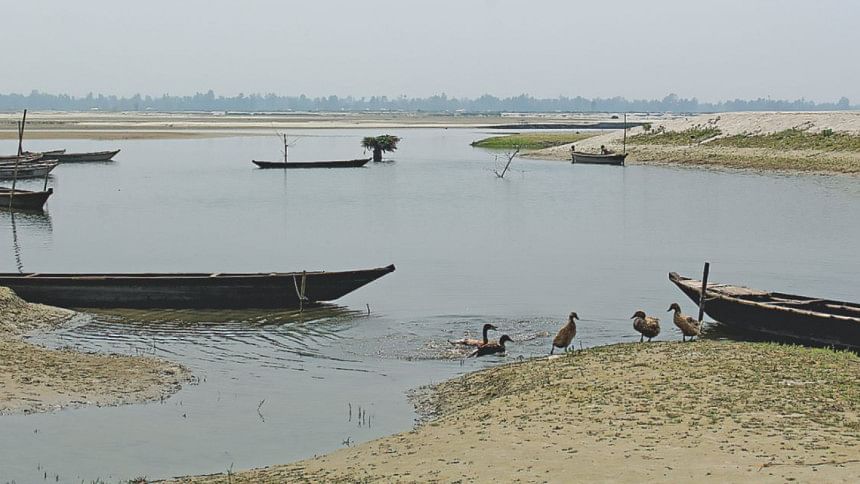
According to his accounts, all the men we saw catching fish near the barrage were actually farmers. Due to extensive damming and diversion of water, Teesta River has significantly changed its course in the last ten years. Massive chars have formed on the river bed, and their expanding sands have engulfed the croplands along the former riverbed.
Abu Bakar alone has lost 35 bighas of land to the growing chars of Teesta. He explained, “Teesta Barrage was built for the farmers of the upstream side of the river. We rarely got benefit of this barrage. However, the situation became unbearable when water started to be diverted towards India.” According to his accounts, some 20 years ago, Teesta used to flow at least 30-35 miles eastwards and take a meandering course to reach the barrage. All along the river were fertile croplands and wetlands teeming with fish. Due to water diversion from the Gajaldoba barrage and consequent siltation, the course of the river has changed, and wetlands and croplands have disappeared. Once prosperous farming villages along the downstream of Teesta River have now turned into poor fishing villages.
“We catch small fish here such as Bain (Mud-Eel), putis (Pool Barb), Bourani (Bengal Loach), Tengras (Gangetic Mystus), Taaki (Spotted snakehead) etc. Some of these we sell in the local market and some we keep for our own consumption. Sometimes we get some donations from local NGOs. In this way we are living hand to mouth. Our family members often press us to move from these barren lands. But where shall we go? Who will give us work if we move to the cities?” asks a desperate Abu Bakar.
According to Abu Bakar and his friends, the original fishermen of Teesta River have moved further downstream. In fact, in Daspara village of Lalmonirhat district's Teesta upazila, we found some fishermen who have recently settled here from the villages of the upstream side of the barrage. Around 200 fishermen families have recently settled in Daspara and Modiram villages. They have also formed an association of fishermen to help each other's survival.
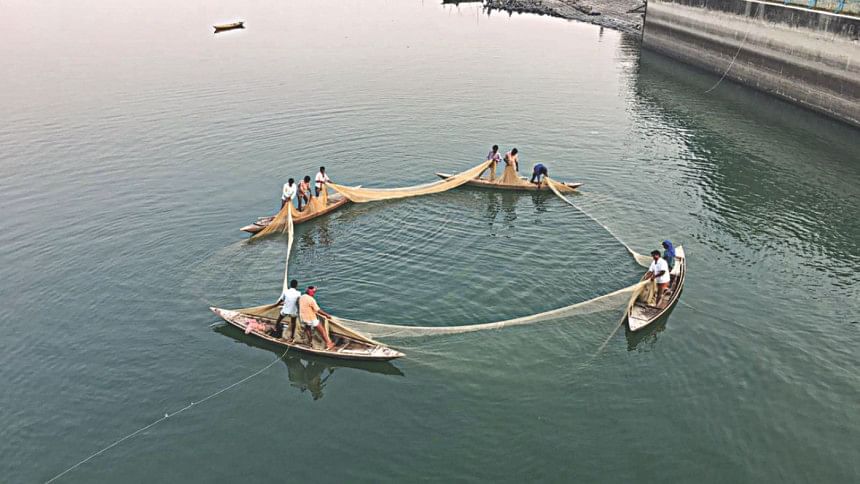
Near Daspara village, which is some 60 kilometres downstream from the Teesta barrage, Teesta's riverbed becomes a massive char dotted with shallow waterholes. After walking for several hours through the char, a once narrow stream has now become the main course of the river. There, we found a couple of men still fishing on the river with boats and nets.
Gajen Chandra Biswas, a sexagenarian fisherman, is their leader. He has moved houses eight times so far—sometimes due to river erosion and sometimes due to unavailability of fish caused by the changing course of the river. Many of his neighbours have moved a lot more than him. When asked why they have settled here, he replies, “Our main source of income is getting fishing contract in the private ponds. There are several ponds nearby and through our association we get contracts to harvest the ponds. This is our main means of survival.”
However, the number of ponds is also shrinking due to the drying up of the river, and most of the fishermen are not lucky enough to get such contracts due to brutal competition. “Local influential people often threaten us not to bid for the contracts. By convincing the local politicians they take the contracts and we have to go back to the Teesta River for survival. We cannot say anything because we are not locals and we are also very poor,” says Gajen.
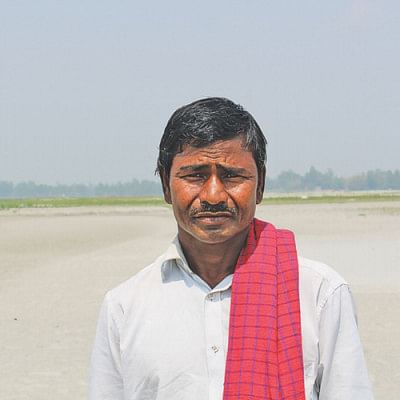
Due to shortage of fish, Gajen, with some of his neighbours, had also migrated to Chattogram to try their luck in deep sea fishing. After spending seven years doing that and earning around Tk 50,000, he decided to return home. “Deep sea fishing was too risky for me and I was feeling really homesick. After returning, I spent some of the money in moving my house. Then I built two boats and a couple of fishing nets. I lease them to destitute fishermen who fish in the river and share their catch with me.”
Due to the intensifying scarcity of water, the number of destitute fishermen is increasing. Destitute farmers—victims of river erosion—are also becoming dependent on fishing, adding to the pressure on the poor fishermen and their shrinking supply of fish. When they cannot withstand the suffering, they have to move in search of a better place for fishing. A once busy, thriving fishing community is now being forced to lead a semi-nomadic life.
“There are days when we cannot catch anything. In those days, we have to starve with our family members. We don't get any help from the government. If the river does not favour us this monsoon, we might move our homes again. We simply don't know what will happen to us. Things are just getting worse. With the demise of the Teesta River, all means of our survival are also vanishing day by day,” he says.
Md Shahnawaz Khan Chandan can be contacted at [email protected].

 For all latest news, follow The Daily Star's Google News channel.
For all latest news, follow The Daily Star's Google News channel. 



Comments